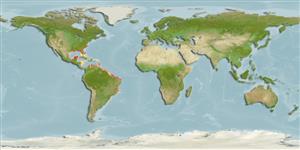Bivalvia |
Cardiida |
Cardiidae
Environment: milieu / climate zone / গভীরতার পরিসীমা / distribution range
বাস্তুসংস্থান
; গভীরতার পরিসীমা 0 - 30 m (সূত্র 83435). Tropical
Western Central Atlantic: USA and Mexico.
Length at first maturity / আকৃতি / Weight / Age
পরিপক্কতা : Lm ? range ? - ? cm Max length : 11.9 cm DL পুরুষ/ লিঙ্গ অনিধর্ারিত ; (সূত্র 83435)
Diagnostic features: Shell very large for family, inflated, obliquely ovate. Sculpture of about 32 to 36 rounded, smooth radial ribs. Pallial line simple. Margins crenulated. Umbones rounded. Colour: pale tan to yellowish brown, mottled irregularly with red-brown. Posterior slope mahogany brown. Interior salmon pink (Ref. 344).
It has a size of 12.5 cm (Ref. 344). Maximum depth from Ref. 104365. Habitat: Buried in sand in shallow subtidal environments (Ref. 344).
Life cycle and mating behavior
পরিপক্কতা | প্রজনন | ডিম ছাড়া | Eggs | ডিম্বধারন ক্ষমতা | Larvae
Members of the class Bivalvia are mostly gonochoric, some are protandric hermaphrodites. Life cycle: Embryos develop into free-swimming trocophore larvae, succeeded by the bivalve veliger, resembling a miniature clam.
Leal, J.H. 2003 Bivalves. p. 25-98. In Carpenter, K.E. (ed.). The living marine resources of the Western Central Atlantic. Volume 1: Introduction, molluscs, crustaceans, hagfishes, sharks, batoid fishes, and chimaeras. FAO Species Identification Guide for Fishery Purposes and American Society of Ichthyologists and Herpetologists Special Publication No. 5. 1600p. (সূত্র 344)
IUCN Red List Status
(সূত্র 130435: Version 2025-1)
CITES status (সূত্র 108899)
Not Evaluated
Not Evaluated
Threat to humans
Human uses
মৎস্য: বাণিজ্যিক
| FishSource |
হাতিয়ার
আরো তথ্য
ট্রফিক বাস্তুতন্ত্র Food items (preys)
পথ্য উপাদান
খাদ্য গ্রহণ
শিকারী প্রাণী সমূহ
Population dynamicsবৃদ্ধি
Max. ages / sizes
Length-weight rel.
Length-length rel.
Length-frequencies
Mass conversion
প্রাচুর্য
Life cycleপ্রজনন পরিপক্কতা ডিম্বধারন ক্ষমতা ডিম ছাড়া EggsEgg developmentLarvae Physiologyঅম্লজান ব্যবহার
Human RelatedStamps, coins, misc.
ইন্টারনেট সুত্র
Estimates based on models
Preferred temperature
(Ref.
115969): 23.2 - 28.2, mean 26.8 (based on 495 cells).
Fishing Vulnerability
Low vulnerability (10 of 100).
